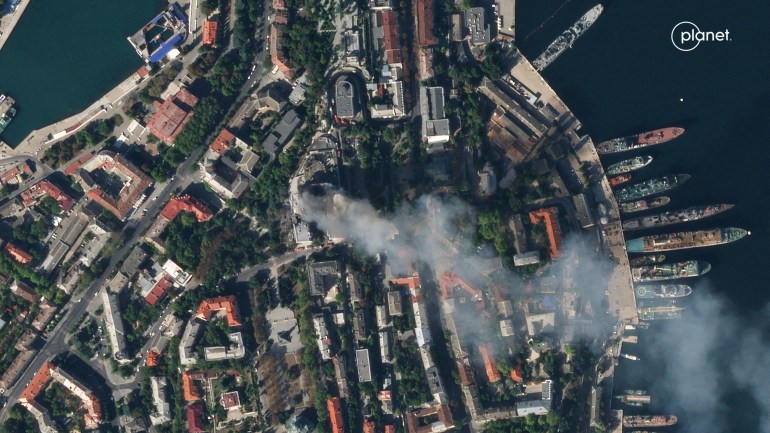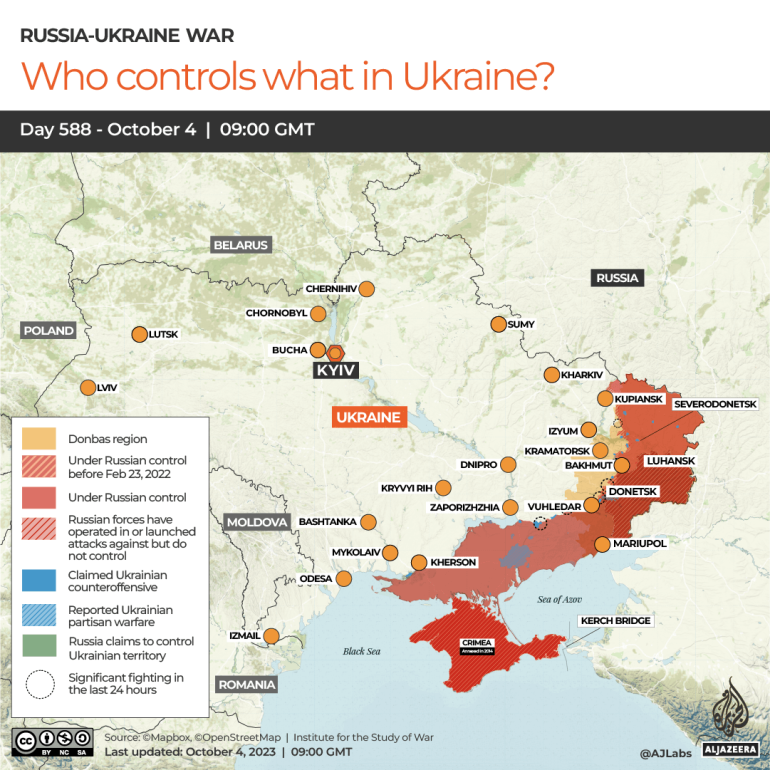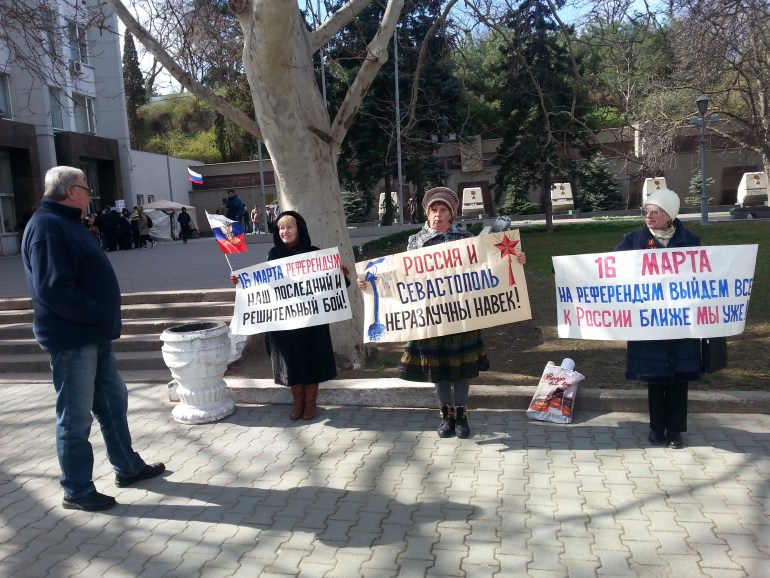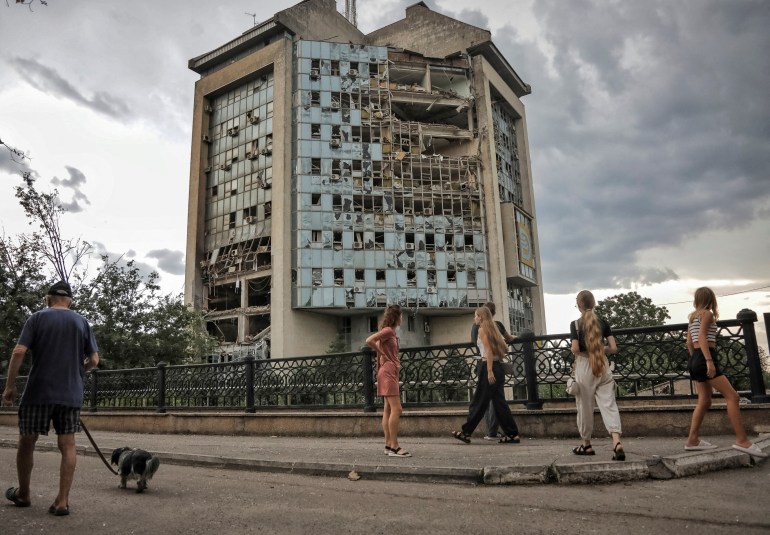It is what Ukrainian servicemen stationed on the Zmiiny Island, or Snake Island, in the Black Sea replied to the Russian warship’s urge to surrender.
But by early 2022, the Russian Black Sea Fleet based in annexed Crimea, seemed to have gained absolute control over Ukraine’s territorial waters in the Black Sea and its smaller, shallower sibling, the Sea of Azov.
Its larger ships shelled Ukraine’s main seaport, Odesa, and other southern cities with missiles and drones, killing civilians and destroying apartment buildings, military installations and port infrastructure.
Smaller Russian navy vessels stopped and officiously inspected merchant ships carrying grain and sunflower oil, Ukraine’s key exports.
Russian navy felt at ease in all of the Black Sea’s northern part – but after almost 600 days of war, the tables have turned.
“They miscalculated,” Lieutenant General Ihor Romanenko, the former deputy chief of Ukraine’s general staff of armed forces, told Al Jazeera. “We won’t let them rest and won’t rest ourselves until we fully de-occupy our lands.”
Fleeing Sevastopol
Satellite imagery shows that at least a dozen Russian vessels, including guided missile frigates, landing ships and submarines, have been hastily relocated from their main base in Sevastopol, a subtropical port in annexed Crimea.
Most were moved to the Russian port of Novorossiisk more than 300km (186 miles) east of Sevastopol, or on other, smaller bases or bays in eastern Crimea or along Russia’s Black Sea coast.
British Defence Minister James Heappey compared the “functional defeat of the Black Sea Fleet” to the liberation of Kharkiv Oblast one year ago.
“The fleet has been forced to disperse to ports from which it cannot have an effect on Ukraine,” he said on Tuesday.
The relocation follows a series of daring Ukrainian attacks with Western-supplied cruise missiles and domestically assembled aerial and naval drones that destroyed flagships, smaller cutters and even a docked submarine.

They also annihilated two advanced S-400 air defence systems creating sizeable “holes” in the sky over Crimea.
And, most importantly, they damaged a major shipyard with a dry dock that was essential for repairing decades-old Russian ships.
“What was critical for Russia wasn’t damage to vessels, it was damage to the shipyard,” Kyiv-based analyst Ihar Tyshkevich told Al Jazeera. “This is the reason why a large part of the Black Sea fleet vessels were relocated to Novorossiisk.”
On September 22, Kyiv barraged and partially destroyed the Fleet’s headquarters in a snow-white Stalinist building in Sevastopol.
Regaining northwestern Black Sea
The attacks dramatically reduced Russia’s capabilities to land troops near Odesa and back occupying forces in the southern region of Kherson, analysts have said.
“Ukraine’s actions have wrested control of Ukraine’s western territorial waters back from Russia and prevented the Black Sea Fleet from threatening Odesa with amphibious assault or providing tactical fires and logistical support to Russian forces in Kherson,” retired US Army Major General Gordon Skip Davis Jr told Al Jazeera.
The success seems even more staggering given that Ukraine’s minuscule navy lost most of its ships during Crimea’s 2014 annexation and consists of two dozen obsolete vessels that can all fit into a tiny bay.

The possibility of future sea drone attacks deterred Russian ships that inspected vessels with Ukrainian grain.
Russian ships “can defend themselves with a relative effect only if there’s a group of vessels”, while inspections make logistical sense only if carried out by individual ships, analyst Tyshkevich said.
However, these days, Ukrainian and international shipping companies prefer to use smaller vessels that can move along the Black Sea coast towards Romanian ports on the Danube, a gateway to Eastern and Central Europe.
But “the Danube ports are not deep, a Panamax ship [with a tonnage of more than 50,000] won’t enter them, and the cargo needs to be reloaded either at sea or in other ports,” Kyiv-based analyst Aleksey Kushch told Al Jazeera.
Therefore, the overall capacity of the Odesa port fell tenfold, and only about 20 vessels carrying about 100,000 tonnes of wheat leave it every month, he said.
The fleet that could have been Ukrainian
The irony is that the entire Black Sea fleet could have been Ukrainian if it was not for the pacifism of its early leaders – and Ukraine’s dire economic situation in the 1990s.
Founded in Sevastopol in 1783, the fleet won naval battles wars with Ottoman Turkey, fought Nazi Germans and often confronted NATO in the Mediterranean.
Ukraine proclaimed independence on August 24, 1991, and just days later, Moscow appointed Admiral Igor Kasatonov as head of the gargantuan fleet that employed some 100,000 servicemen and 60,000 auxiliary staffers serving 833 warships and hundreds of aircraft.
It had bases in what is now Russia, Moldova and Georgia, and Soviet naval outposts in Syria and Libya reported to it.
Kasatonov arrived in Kyiv in early 1992 to meet Ukraine’s first post-Soviet President Leonid Kravchuk and pledge allegiance to Kyiv, a witness said.
But the meeting did not go well, and he ran out of it “absolutely crazy”, photographer Efrem Lukatsky told Al Jazeera.
“He began to spill his guts to me, and said that [Kravchuk], as it turns out, didn’t need the Fleet,” he said.

The decision seemed logical at the time as Ukraine simply could not afford to maintain the fleet, and Kasatonov pledged allegiance to Russia on January 4, 1992.
Moscow and Kyiv decided to run the fleet jointly as idle ships rusted away and were often sold for scrap metal.
Rumours had it that even Colombian drug cartels could buy a small submarine for smuggling cocaine.
Only in 1997, Moscow and Kyiv partitioned the fleet – very unevenly.
Kyiv got 30 warships and cutters, one submarine, 34 auxiliary ships and 90 aircraft.
Moscow got 338 warships, 106 planes and helicopters and agreed to lease several bases in and around Sevastopol and several other locations in Crimea.
The lease cost Russia almost $100m annually, and the fleet remained the largest employer in Sevastopol.

Since the 1944 Stalinist deportation of several Crimean communities – Tatars, Greeks, Armenians and Bulgarians – Moscow moved hundreds of thousands of ethnic Russians to the peninsula.
They largely remained loyal to Moscow and stubbornly resisted Kyiv’s attempts to promote Ukrainian as the language of administration and education.
Politically, they were close to the Russian “red belt” regions that supported Communists.
“Ukrainian Crimea mentally was a total part of it,” Sergey Biziykin, a fugitive Russian opposition activist who visited Crimea in the early 2000s, told Al Jazeera.
Kremlin-controlled media widely available in Crimea transformed its residents’ pro-Communist sympathies into loyalty to Russia in general as cash-strapped Kyiv did not invest in the peninsula’s decaying infrastructure.
“They ignore us, they see us as a place for cheap vacations,” Valentina Minina, a pro-Moscow protester in Sevastopol holding a Russian flag, told this reporter just days before the March 16, 2014 “referendum” that heralded Crimea’s annexation. “We want to be with Russia because it respects us, it will make things right here.”
